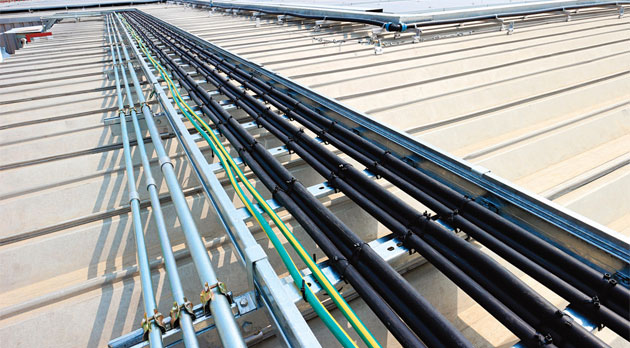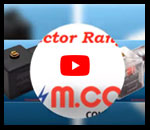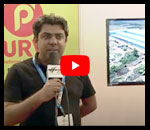Optimising Power Flow: Emerging cable and conductor technologies

The increasing demands for energy can be met through advanced power cables and conductors. The cable and conductor markets are witnessing innovation in technologies that can withstand high temperatures and achieve seamless high voltage power transmission. At present, these technologies focus on increasing the power-carrying capacity, efficiently distributing energy over long distances with minimal energy losses and improving grid stability and reliability. The new conductor and cable technologies play a crucial role in minimising transmission losses, optimising power flow, integrating intermittent renewable energy sources and enhancing system stability.
The following sections discuss emerging cable and conductor technologies…
HTLS conductors
One of the fast emerging conductor technologies is high temperature low-sag (HTLS) conductors, which, for the same diameter as the aluminium conductor steel reinforced (ACSR), can operate at temperatures up to 250 degrees Celsius. Besides, HTLS conductors require less thermal elongation than ACSR conductors. One technique to raise the thermal rating of existing lines is replacing ACSR conductors with HTLS conductors while maintaining the same right of way (RoW). The installation and operation of HTLS conductors do not require significant alterations to existing foundations and structures. High temperature superconducting (HTS) cables are a revolutionary development in power transmission. HTS cables are extremely efficient and can transport greater power over longer distances since they can transmit energy with zero resistance, in contrast to conventional copper or aluminium conductors. Due to their lighter and more compact design compared to conventional counterparts, they are being used in urban settings where space is at a premium.
Broadly, HTLS conductors are classified into four categories: aluminium conductor composite core (ACCC), aluminium conductor steel supported (ACSS), super thermal aluminium conductor invar reinforced (STACIR) and gap-type thermal-resistant aluminium alloy ACSR conductor (gap conductor).
ACCC conductors comprise a carbon composite core and trapezoidal-shaped annealed aluminium. They can double the power transfer capacity, have lower sag at high operating temperatures and result in reduced carbon emissions and 20-30 per cent less line loss.
ACSS conductors are manufactured from annealed aluminium 1350 wires and an inner high tensile strength core of Galfan (Zn-5% Al-mischmetal)-coated steel wires. These conductors are capable of operating at up to 250 degrees Celsius, have low loss due to annealed aluminium and are easy to install.
STACIR conductors are manufactured from aluminium zirconium alloy rods, offering 100 per cent more transfer capacity and but incurring high losses. These conductors have a strong inner invar steel core and concentrically arranged super thermal aluminium strands that form the outer layer of the conductors.
Gap-type thermal-resistant aluminium alloy ACSR conductors or gap conductors have a gap filled with heat-resistant grease between the steel core and innermost layer to reduce resistance between the two layers and prevent corrosion.
Covered Cables
Covered cables are gaining traction in the market because of the dangers associated with unprotected overhead cables. Commonly used covered cables include aerial bunched cables, spacer cable systems, high-density polyethylene cables and cross-linked polyethylene (XLPE) cables.
Cross-linked polyethylene serves as the primary insulating material in XLPE cables, which can withstand greater temperatures under both normal loads and short circuit circumstances. Utilities are increasingly using extruded XLPE cables to install transmission infrastructure in challenging terrain. XLPE cables can function at high temperatures and are rated for higher current capacities. Overhead power lines, known as aerial bunched cables, utilise multiple insulated phase conductors that are bundled together. Additionally, they often have a single neutral conductor. These cables are considered more dependable and safer than traditional overhead distribution systems with bare conductors. They are also more cost-effective and have reduced power losses.
Spacer cables, a type of overhead power transmission line technology, incorporate spacers or insulating devices to separate the conductors, allowing them to be placed closer together without compromising safety. This design aims to enhance the overall performance of power transmission lines by increasing efficiency and capacity.
High-density polyethylene (HDPE) cables are insulated cables made of thermoplastic polymer known for their high strength-to-density ratio, chemical resistance and durability. HDPE cables are resistant to corrosion, which is particularly beneficial in applications where cables may be exposed to harsh environmental conditions. Their lightweight design makes them advantageous for installation and transportation, with a low dielectric constant for maintaining the integrity of electrical signals. Additionally, they have ultraviolet radiation resistance, making them suitable for outdoor applications where cables are exposed to sunlight.
Underground Cables
Underground cables offer better safety against electrocution than overhead wires and are becoming increasingly accepted by state and central transmission utilities. There are several innovations being offered in the cable market that allow utilities to increase their capacities without having to deal with RoW clearance problems. Underground cables require less width for installation compared to the extensive RoW needed for overhead power lines. They are less prone to electromagnetic interference, which can affect sensitive electronic equipment and communication systems. Additionally, they produce lower electromagnetic fields (EMFs) compared to overhead lines, addressing concerns related to potential health effects associated with prolonged exposure to high EMF levels.
Solar Cables
Solar cables are another cutting-edge technology gaining traction in the Indian markets for the safe transfer of energy from solar panels to inverters, ensuring stability. They are used as connections for vital equipment and function as a means of transporting solar energy throughout a solar system. They can withstand severe weather conditions because of their exceptional mechanical strength. Over the course of a solar project, these cables are usually installed outdoors and exposed to high temperatures. These modern cables are designed to withstand harsh weather conditions and outdoor settings. They are constructed from premium materials that are resistant to heat, moisture, cold and ultraviolet rays, guaranteeing the solar energy system’s dependability and safety. Additionally, high quality solar cables enable solar panels to operate more efficiently, producing cleaner energy and lowering carbon emissions.
Gas-Insulated Lines
Although gas-insulated lines (GILs) have not been widely adopted in the market, they are gaining traction globally. In situations where RoW is inaccessible for the transmission of electricity, GILs are a practical substitute for overhead wires. This is mainly because they can be placed in ditches, tunnels and even below ground. In addition, GILs have less resistive losses compared to overhead wires and provide increased dependability with reduced fire risks. The insulating medium in GILs are sulfur hexafluoride and nitrogen hexafluoride. Its primary insulation consists of aluminium conductors supported by sealed tubes that are pressurised with a gas mixture of nitrogen and sulphur hexafluoride in an 80:20 ratio.
Smart Cables
Smart cables are a result of the incorporation of sensors and communication technologies into power and control lines. These cables have built-in health and performance monitoring, which allows them to instantly identify problems such as damage and overheating. This proactive maintenance strategy improves the overall reliability of electrical systems and helps avoid costly downtimes.
Conclusion
Net, net, there is an increased deployment of cables and conductors that minimise RoW requirements and operate efficiently at high temperatures. Going forward, the use of lightweight and flexible cables is expected to gain traction. These include cables made of light materials such as nanotubes, graphene and high-strength polymers that are easy to install and reduce the risk of damage. Overall, conducting a cost-benefit analysis to suit specific requirements is essential for achieving the best results.























